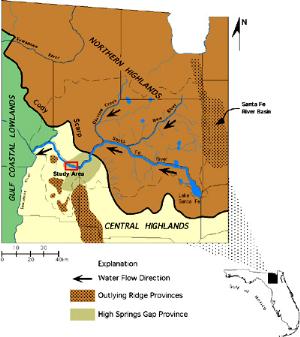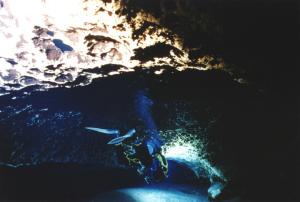|
Hydrogeologic Setting
Florida Karst
Karst in Florida is formed when precipitation absorbs
CO2 from organic material in soils to form carbonic acid
which dissolves the Eocene and Oligocene limestones that constitute
the majority of the bedrock in the state. Sinkholes such as the
famed Winter Park sinkhole in central Florida are a common land
form and provide evidence of the extensive karstification. Other
abundant but less recognized karst features are extensive caves
that have developed in the limestones beneath the water table.
Because these features are completely submerged, they are
inaccessible to most researchers. However, cave-divers have been
exploring, mapping, and documenting these karst caves since the
1950's. After more than 40 years of such efforts, north-central
Florida is now recognized globally for an abundance of large and
extensive phreatic cave systems.
The phreatic cave systems in Florida are of particular
hydrogeological interest because of the large volumes of water they
transmit from upland recharge areas to spring discharge points on
Florida's major rivers such as the Suwannee, the St. Johns, the
Santa Fe, the Oklawaha, and the Withlacoochee. All of the first
magnitude springs in Florida are the discharge points for major
phreatic cave systems.
Where the Floridan aquifer is confined by impermeable layers,
recharge occurs through sinkholes and other discrete points that
breach the confining layer and penetrate the limestones. Acidic
waters dissolve conduits that become larger downgradient until they
terminate at spring discharge points. Manatee spring on the
Suwannee river near Chiefland, Florida is a perfect example. There,
a conduit approximately 7 m in diameter extends for over 3 km from
the spring that discharges 5.0 m3/s into the upland
recharge area. Other examples include: Silver spring on the
Oklawaha river near Ocala, Florida (22.8 m3/s
discharge), Blue spring on the St. Johns river near Orange City,
Florida (4.5 m3/s discharge), and Blue spring on the
Withlacoochee river near Madison, Florida (3.2 m3/s
discharge). Average discharges for the largest springs in Florida
are provided by Lane (1986).
On an even larger scale, dendritic cave systems form when
conduits stemming from several discrete recharge points converge on
a single spring. The Woodville karst plain in the central panhandle
of Florida contains one of the most extensive dendritic cave
systems ever documented. Wakulla spring with an average discharge
of over 10.9 m3/s is the major discharge point for the
entire Woodville karst plain which hydraulically connects
Tallahassee, Florida with the Gulf of Mexico. Over 60 km of
independent phreatic caves have been physically mapped in the
region and have been connected by dye tracing. Conduits in the
Woodville karst plain reach up to 30 m in diameter and trend at a
depth of approximately 90 m. Active exploration is now being
conducted that is adding over 2 km per month to the underground map
of the Woodville karst plain. When the inevitable connections are
made there, the Wakulla spring system will be the largest known
phreatic cave system in the world. In order to appreciate the size
of this particular cave system, consider that the discharge from
just Wakulla spring could supply each person in Florida with more
than 70 liters of fresh water per day based on a 1992 census of
over 13 million residents.
In regions where the confining layer is absent, precipitation
infiltrates directly to the aquifer creating anastomosing cave
systems. Typically in these regions, smaller conduits extend from
beneath a karstified limestone surface and trend downgradient
toward large conduits that discharge to rivers and streams. In many
cases, however, where the limestone surface is dissected by streams
or rivers, part or all of the river flow is diverted underground
into the large conduits. Many rivers and streams in Florida such as
the Santa Fe and Alapaha rivers are diverted underground
immediately after they flow into regions where the Floridan aquifer
is unconfined. Even after the rivers discharge back to the land
surface, ground water and river water are continually exchanged
because of the absence of a confining layer beneath the river bed.
The Devil's Ear cave system studied during this investigation is a
perfect example of an anastomosing cave system that both
distributes and receives water from an overlying river.
Permeabilities associated with these dissolved conduit systems
far surpass that of the bedrock even though the limestone itself is
highly transmissive. The conduit permeabilities thus present an
overwhelming control on the regional ground water flow patterns.
Rather it infiltrates directly or drains into sinkholes, water
flows through small tubes that feed larger conduits and eventually
discharges at springs. Cave maps provide an excellent picture of
the ground water flow patterns, however, since cave-divers are
restricted to conduits passable by humans, they represent only a
small fraction of the interconnected tubes that dominate the
permeability structure of the Floridan aquifer.
The Santa Fe River Basin
The Santa Fe river basin comprises over 3,500 km2 of
land in north-central Florida and is a major tributary to the
Suwannee river. The region is characterized as semi-tropical with
mean annual precipitation of 135 cm, 52% of which falls between the
months of June and September. The large seasonal variation in
precipitation renders the Santa Fe river basin very susceptible to
flooding. The principal source of ground water throughout the basin
is the Floridan aquifer which consists of a thick sequence of
Eocene to Oligocene limestones, the upper 100 - 250 meters of which
yield potable water. Transmissivities in the upper 60 m of the
Floridan aquifer range from 3,000 to 50,000 m2/day
permitting well yields of between 7,500 to 20,000 L/min (Hunn and
Slack, 1983). Even the greatest well yields are an order of
magnitude less than spring discharges from the Devil's Ear cave
system.
The Ocala Limestone, formerly the Ocala Group (Scott, 1992),
Hawthorn Formation, and Alachua Formation are the three geologic
units present in all or part of the Santa Fe river basin that are
significant to this investigation. The Ocala Limestone, a thick
sequence of highly permeable Eocene limestone beds, is the
predominant geologic formation comprising the Floridan aquifer.
Extensive karstification in the Ocala Limestone has created
anisotropic conditions where permeability has increased by many
orders of magnitude in dissolved conduits. The Hawthorn Formation
is a 25 to 30 m thick Miocene sequence of phosphatic clays and
dolomitic limestones that overlies the Ocala Limestone in the
eastern Santa Fe river basin. Where present, the Hawthorn Formation
effectively confines the Floridan aquifer. The Alachua Formation is
a thin sequence of phosphatic sand and clay deposits thought to be
erosional remnants of the Hawthorn Formation that exist as outlying
hills and ridges in the western part of the Santa Fe river basin
covering the Ocala Limestone (Williams et al., 1977). The Alachua
Formation is ineffective at confining the Floridan aquifer (Hunn
and Slack, 1983).
Figure 3 adapted from White (1970) shows the location of the
Devil's Ear cave system and the course of the Santa Fe river across
the three physiographic provinces that merge within the Santa Fe
river basin: the Northern Highlands, Central Highlands, and Gulf
Coastal Lowlands. The basin is divided into two distinct zones, the
eastern half lying in the Northern Highlands and the western half
which is subdivided by the Central Highlands and Gulf Coastal
Lowlands. The Santa Fe river originates in the Northern Highlands,
a large flat plateau ranging in elevation between 50 and 60 m where
the Floridan aquifer is confined by the Hawthorn Formation.
Precipitation in the Northern Highlands drains to the Santa Fe
river and it's tributaries (Hunn and Slack, 1983).
 |
Figure 3. Location of the Devil's Ear cave
system and course of the Santa Fe river from the Northern Highlands
across the Cody Scarp onto the limestone plains of the Central
Highlands and Gulf Coastal Lowlands physiographic provinces in
north-central Florida. Adapted from White, (1970). Copyright Todd
R. Kincaid
The Santa Fe river flows west across the Northern Highlands to
the Cody Scarp, an extensively karstified transition zone between
the confined and unconfined parts of the Floridan aquifer (Scott,
1991) where it disappears into O'leno sink. From O'leno sink, the
river flows underground for over 5 km to its resurgence at the
River Rise. From there, the river flows onto the lowland limestone
plains of the Central Highlands and Gulf Coastal Lowlands where the
Floridan aquifer is unconfined and precipitation infiltrates
directly into the aquifer. Below the River Rise, the Santa Fe river
is both a gaining and loosing stream. It receives considerable
water from several springs, however, less noticeable are the
frequent “sucks” where part of the flow is diverted
underground for some distance (Ellins et al., 1991; Kincaid,
1994).
Hisert (1994) conducted tracing experiments at O'leno State Park
which demonstrated that, after disappearing into O'leno sink, the
Santa Fe river flows at over 5 km/ day to its resurgence point at
the River Rise. Hisert recorded the ground water tracer at 8
intermediate sinkholes between O'leno sink and the River Rise which
are now known to be karst windows that intersect the underground
flow path of the river. Furthermore, he found that over 40% of the
resurgence at the River Rise is ground water that augmented the
river flow.
The Devil's Ear Cave System
The Devil's Ear cave system has developed in the High Springs Gap
sub-province of the Central Highlands. The cave system is an
anastomosing network of underwater conduits in the Ocala Limestone.
Conduit diameters range from 2 to 20 m (Figure 4). Compared to
other phreatic caves in Florida, the Devil's Ear cave system is
only slightly larger than average. However, it's proximity and
relationship to the Santa Fe river make it hydrologically
important.
 |
Figure 4. A cave-diver in the main passage
of the Devil's Ear cave system. Photo by Wes Skiles of Karst
Productions. Copyright Wes Skiles.
As shown on Figure 5, small tubes and conduits extend from the
recharge area on the north side of the river to a larger conduit
that parallels and, in places, directly underlies the river. Three
springs (July, Devil's Eye, and Devil's Ear) discharge most of the
water from the cave to the river. The combined discharge from these
springs averages 8.5 m3/s (Wilson and Skiles, 1988). The
main conduit in the cave system trends east-west for over 1,500 m
upstream from the entrance at Devil's Ear spring. The depth of the
conduits is relatively consistent at 33 m below the water surface
in the river except where they rise to meet the Santa Fe river at
the three principal springs. Three regions of the cave system shown
on Figure 5 as A, B, and C, are the closest to the Santa Fe river.
In these regions, dissolved joints in the limestone that are
passable by divers proceed up to a depth of less than 3 m.
 |
Figure 5. Map of the Devil's Ear cave
system underlying the 1.5 km reach of the Santa Fe river upstream
of July spring in north-central Florida, showing the course of the
Santa Fe river relative to the conduits, direction of ground water
flow in the conduits, and the location of the three principal
discharge points. Copyright Todd R. Kincaid & Steve
Burman.
Water clarity in the conduits is typically clear but becomes
turbid during higher stages of the river or after flood events.
During periods of turbid water discharge at the three springs,
cave-divers report that clear water enters the main passage from
the northern conduits and mixes with turbid water from the southern
conduits producing the turbid water discharge visible at the
surface. Reverse flow, a common situation at many springs in
Florida where spring discharge is reversed and river water flows
into a cave system through the spring opening, has never been
reported at the Devil's Ear cave system. The absence of reverse
flow during high river stages reflects the unconfined condition of
the Floridan aquifer and reveals that the aquifer is receiving
direct recharge from the river.
|